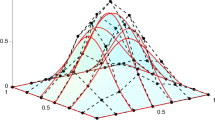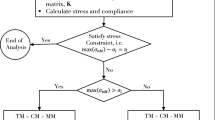Abstract
In this paper, the solid isotropic material with penalisation (SIMP) method for topology optimisation of 2D problems is reformulated in the non-uniform rational BSpline (NURBS) framework. This choice implies several advantages, such as the definition of an implicit filter zone and the possibility for the designer to get a geometric entity at the end of the optimisation process. Therefore, important facilities are provided in CAD postprocessing phases in order to retrieve a consistent and well connected final topology. The effect of the main NURBS parameters (degrees, control points, weights and knot-vector components) on the final optimum topology is investigated. Classic geometric constraints, as the minimum and maximum member size, have been integrated and reformulated according to the NURBS formalism. Furthermore, a new constraint on the local curvature radius has been developed thanks to the NURBS formalism and properties. The effectiveness and the robustness of the proposed method are tested and proven through some benchmarks taken from literature and the results are compared with those provided by the classical SIMP approach.






















Similar content being viewed by others
References
Allaire, G., Jouve, F., Toader, A.M.: Structural optimization using sensitivity analysis and a level-set method. J. Comput. Phys. 194, 363–393 (2004)
Allaire, G., Jouve, F., Michailidis, G.: Thickness control in structural optimization via a level set method. Struct. Multidiscip. Optim. 53(6), 1349–1382 (2016)
Altair Engineering: OptiStruct 13.0 Reference Guide (2014)
Ansys Inc.: ANSYS 16.0 Structural Analysis Guide (2015)
Auricchio, F., da Veiga, L.B., Hughes, T.J.R., Reali, A., Sangalli, G.: Isogeometric collocation methods. Math. Models Methods Appl. Sci. 20(11), 2075–2107 (2010)
Bendsoe, M., Kikuchi, N.: Generating optimal topologies in structural design using a homogenization method. Comput. Methods Appl. Mech. Eng. 71, 197–224 (1988)
Bendsoe, M., Sigmund, O.: Topology Optimization: Theory, Methods and Applications. Springer, Berlin (2003)
Costa, G., Montemurro, M., Pailhès, J.: A nurbs-based topology optimisation method including additive manufacturing constraints. In: 7th International Conference on Mechanics and Materials in Design (2017)
de Ruiter, M.J., van Keulen, F.: Topology optimization using a topology description function. Struct. Multidiscip. Optim. 26, 406–416 (2004)
FE-DESIGN GmbH: SIMUILIA Tosca Structure Documentation 8.0 (2013)
Goldman, R.: Curvature formulas for implicit curves and surfaces. Comput. Aided Geom. Des. 22, 632–658 (2005)
Guest, J.K.: Imposing maximum length scale in topology optimization. Struct. Multidiscip. Opim. 37, 463–473 (2009)
Guest, J.K., Prvost, J.H., Belytschko, T.: Achieving minimum length scale in topology optimization using nodal design variables and projection functions. Numer. Methods Eng. 61, 238–254 (2004)
Guo, X., Zhang, W., Zhong, W.: Explicit feature control in structural topology optimization via level set method. Comput. Methods Appl. Mech. Eng. 272, 354–378 (2014)
Kreisselmeier, G., Steinhauser, R.: Systematic control design by optimizing a vector performance index. IFAC Proc. Vol. 12(7), 113–117 (1979)
Luo, Z., Tong, L., Wang, M.Y., Wang, S.: Shape and topology optimization of compliant mechanisms using a parameterization level set method. J. Comput. Phys. 227, 680–705 (2007)
Luo, Z., Tong, L., Kang, Z.: A level set method for structural shape and topology optimization using radial basis functions. Comput. Struct. 87, 425–434 (2009)
MathWorks Inc.: Optimization Toolbox Users Guide. The MathWorks Inc, 3 Apple Hill Drive, Natick (2011)
Mercelis, P., Kruth, J.P.: Residual stresses in selective laser sintering and selective laser melting. Rapid Prototyp. J. 12, 254–265 (2006)
Nocedal, J., Wright, S.J.: Numerical Optimization, 2nd edn. Springer, Berlin (2006)
Piegl, L., Tiller, W.: The NURBS book. Springer-Verlag, Berlin, Heidelberg, New York (1997)
Poulsen, T.: A new scheme for imposing a minimum length scale in topology optimization. Int. J. Numer. Methods Eng. 57, 741–760 (2003)
Qian, X.: Topology optimization in b-spline space. Comput. Methods Appl. Mech. Eng. 265, 15–35 (2013)
Sethian, J.A.: Level Set Methods and Fast Marching Methods: Evolving Interfaces in Computational Geometry, Fluid Mechanics, Computer Vision, and Materials Science. Cambridge University Press, Cambridge (1999)
Sigmund, O.: A 99 line topology optimization code written in Matlab. Struct. Multidiscip. Opim. 21, 120–127 (2001)
Sigmund, O.: Manufacturing tolerant topology optimization. Acta. Mech. Sin. 25, 227–239 (2009)
Svanberg, K.: The method of moving asymptotes: a new method for structural optimization. Int. J. Numer. Methods Eng. 24, 359–373 (1987)
van Dijk, N.P., Maute, K., Langelaar, M., van Keulen, F.: Level-set methods for structural topology optimization: a review. Struct. Multidiscip. Optim. 48, 437–472 (2013)
Wang, F., Lazarov, B.S., Sigmund, O.: On projection methods, convergence and robust formulations in topology optimization. Struct. Multidiscip. Opim. 43(6), 767–784 (2011)
Wang, S.Y., Wang, M.Y.: Radial basis functions and level set method for structural topology optimization. Int. J. Numer. Method Eng. 65(12), 2060–2090 (2006)
Wang, Y., Benson, D.J.: Geometrically constrained isogeometric parametrized level-set based topology optimization via trimmed elements. Front. Mech. Eng. 11(4), 328–343 (2016)
Yamada, T., Izui, K., Nishiwaki, S., Takezawa, A.: A topology optimization method based on the level set method incorporating a fictitious interface energy. Comput. Methods Appl. Mech. Eng. 199, 28762891 (2010)
Zhou, M., Lazarov, B.S., Wang, F., Sigmund, O.: Minimum length scale in topology optimization by geometric constraints. Comput. Methods Appl. Mech. Eng. 293, 266–282 (2015)
Acknowledgements
The first author is grateful to the Nouvelle-Aquitaine region for its contribution to this paper through the FUTURPROD project.
Author information
Authors and Affiliations
Corresponding author
Appendices
Appendix 1: Sensitivity analysis of compliance and volume fraction
Let G be a generic scalar quantity whose gradient with respect to the mesh elements is known (i.e. \(\frac{\partial G}{\partial \rho _e}\)). Now, the derivatives \(\frac{\partial G}{\partial \overline{\rho _{s,t}}}\) and \(\frac{\partial G}{\partial w_{s,t}}\) need to be computed, where \(\overline{\rho _{s,t}}\) is the generic control point of the NURBS scalar function and \(w_{s,t}\) the respective weight. Let \(I_{s,t}\) be the local support of the blending function associated to the control point \(\overline{\rho _{s,t}}\): it is evident that only those elements lying in the support will contribute to the sensitivity analysis. Therefore, the following general expressions can be inferred by the chaining rule for derivatives:
The derivative \(\frac{\partial \rho _e}{\partial \overline{\rho _{s,t}}}\) can be easily computed from Eq. (20):
The derivative \(\frac{\partial \rho _e}{\partial w_{s,t}}\) is evaluated by explicitly inserting Eq. (2) in Eq. (20). The final expression can be retrieved after few computations:
Consequently, the sensitivity analysis for the compliance and the volume fraction can be deduced combining Eqs. (69) and (70) with Eqs. (18) and (19).
Appendix 2: Sensitivity analysis of constraints
1.1 Sensitivity analysis of the minimum member size constraint
Sensitivity of the monotonicity integral \(M_{\gamma _i}(\rho )\) with respect to the control points:
Sensitivity of the monotonicity integral \(M_{\gamma _i}(\rho )\) with respect to the NURBS weights:
1.2 Sensitivity analysis of the maximum member size constraint
The gradient of the maximum member size constraint is computed here with respect to the NURBS control points and weights:
1.3 Sensitivity analysis of the local curvature radius constraint
The gradient of the local curvature radius is computed with respect to the control points and to the weights. Let us write again Eq. (50) in a more convenient form:
Thus, the derivatives write
The complete expression of Eqs. (76) and (77) are not provided here for sake of brevity; anyway the reader can easily deduce them by using the following formulae to compute the derivatives of each term. They are deduced from the results of “Appendix 1”:
Rights and permissions
About this article
Cite this article
Costa, G., Montemurro, M. & Pailhès, J. A 2D topology optimisation algorithm in NURBS framework with geometric constraints. Int J Mech Mater Des 14, 669–696 (2018). https://doi.org/10.1007/s10999-017-9396-z
Received:
Accepted:
Published:
Issue Date:
DOI: https://doi.org/10.1007/s10999-017-9396-z




